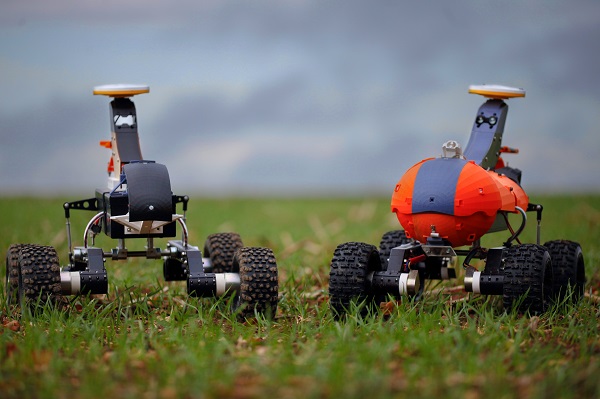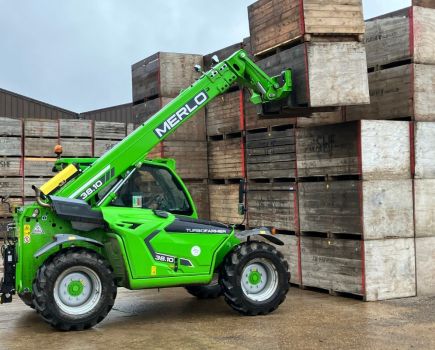Politicians enthuse about it, but whether farming will embrace the fourth industrial revolution or sit sceptically behind the curve may depend on a change of mindset. CPM explores the World of Opportunity.
Farmers in 20 years’ time will think of themselves in a completely different way.
By Tom Allen-Stevens
As a CPM reader, who leans towards the progressive side of agriculture, that headline probably drew you in. But have you truly considered what farming’s fourth industrial revolution (4IR) could mean for your business, how you interact with your land, with society and your family, and how you will exist as a farmer?
That may sound a bit touchy-feely for an industry that talks in terms of hp per m width, that seeks to shave a few % off fuel use, and which applies an agrochemical just in time for an incremental yield gain. But 4IR could do away with all such measures and more, and leave in its wake a generation of producers searching for a new paradigm of what it actually means to be a farmer.

Britney (left) and Rachael – the two prototypes of farmbot Tom who will monitor fields on a plant by plant basis.
It’s this complete change of mindset that lies at the heart of the farming vision towards which the Small Robot Company (SRC) is striving, explains co-founder and Shrops farmer Sam Watson-Jones. “It’s all very well developing a new concept and a new service that will carry out field work. But the danger is that the industry will simply look on Small Robots as tractor replacements – the change is far more fundamental,” he says.
SRC launched around 18 months ago with the concept of a new service where field work would be carried out by a team of three farmbots: Tom, Dick and Harry will plant, feed and weed arable crops autonomously, while Wilma is the AI (artificial intelligence) brain behind the operation, gathering and storing data and applying algorithms to decide tasks. The aim is to cut chemicals by up to 95%, prevent soil erosion and run-off, and reduce cultivation emissions by up to 90%. Significant cost-of-production savings are on the cards for farmers.
Since its launch, SRC has attracted £2.5M in funding, both from private investors (mostly farmers) as well as government funding through its Industrial Strategy. Some of the UK’s brightest brains in robotics and AI are now working with SRC on developing the prototypes and algorithms.
But Sam believes it’s just part of a seismic change agriculture will undergo over the next 10-20 years. “The whole concept of the digital farm opens up a completely new range of possibilities,” he says. “The most successful farmers will be those who look beyond the boundaries that currently limit what the business does. They’ll take on new measures towards achieving a different set of goals – farmers in 20 years’ time will think of themselves in a completely different way.”
And there’s the rub – farming, more than other industries, has historically been relatively reluctant to change, he suggests. “If my great grandfather was to come back to our farm today, I reckon it wouldn’t take him long before he was up to speed with how the business operated. Compare that to a pre-war doctor or engineer – technology has transformed beyond recognition the way in which so many other industries operate.”
It’s a concern shared by Defra and AHDB – both have commissioned research to explore farmers’ decision-making behaviour. Dr David Rose of the University of East Anglia has led some of this and has more recently looked at how the farming industry can overcome some of the barriers to change.
“It’s a big problem in agriculture,” he says. “Companies like Apple and Google know how to market their innovations and have an infrastructure in place that sets out to understand end users, their needs, and preferences. This ultimately makes uptake of their products far more likely.”
In agriculture, however, so often the innovations are developed with no farmer involvement at all, so adoption can be a slow process. “The user-centric design is so important, but one of the difficulties for a manufacturer bringing a new product to market is commercial sensitivity – that’s why so much innovation goes on behind closed doors,” explains David.
Defra-funded work, published in Nov 2016, identified 15 factors that are influential in convincing farmers and advisers to use decision-support tools. These are seen as a route to lead users through decision-making, but similar factors influence uptake of innovations. The core factors are:
- Performance expectancy – the desire for a tool to perform well
- Ease of use – instantaneous results from a tool that’s user-friendly
- Peer recommendation – endorsement from another farmer or through an adviser network is a key determinant
- Trust – there must be faith in the source of the tool
- Cost – a free tool is more likely to be tried
- Habit – whether it fits in with a farmer’s usual routine
- Relevance to user – it should be flexible to serve the needs of the individual
- Farmer-adviser compatibility – it works well when both use the same tool
A number of factors modify the strength of the core factors: age, farm size, farm type, and level of IT education. Facilitating conditions, such as broadband availability and ability to use the tool in wet weather, affect use. Finally, there are driving factors, such as whether its use is needed for compliance purposes and the level of marketing a tool receives.
But once it reaches the farmer, how can you tell if you’re someone who’s more receptive to new thinking? “The first point is that it doesn’t have to be about new technology – it’s the enquiring mind,” David says. “So simply introducing a new system to monitor a key variable, such as tiller counts, could be just as innovative as using a drone or an app.”
Ask yourself if you regularly try something different, he suggests. “If you make mistakes, that’s good, as long as you learn from them.”
And a crucial aspect is to look beyond the farm gate and to have an open, collaborative outlook. “The peer-to-peer approach is one of the strongest drivers of change in agriculture. Those who leave the farm to go to farmer meetings, who join farmer networks, with the aim of learning something new – as well as sharing knowledge – are most likely to catch the bow wave of positive change.”
So what’s his verdict on SRC? “Perhaps the biggest challenge it faces is delivering on performance expectancy – proving there’s value to a system that’s still very much at concept stage will be key. On top of that, there are fundamental issues that all operators in this space face – whether autonomous technology is safe to use, and the socio-economic impact on the industry.”
But David believes some of the difficulties new technologies struggle with may be managed through SRC’s Farming as a Service (FaaS) concept – the farmer doesn’t buy the robots, but pays for a service to be delivered, with all the technical intricacies of the technology handled by SRC engineers. “This service-based model addresses big barriers, such as lack of technical knowledge, and so long as there’s a cost-benefit, the initial cost of buying the technology is minimised.”
What makes SRC stand out in his view is the collaborative approach, however. The concept started through a series of farmer interviews, and a farmer advisory group is regularly consulted and kept up to date with progress. “There seems to be a real appetite to consult and engage with the farming community, shown in the way SRC has set out to understand farmers, the problems they face and address them. This user-led approach has a lot going for it, and I think the work they’ve done so far is interesting, although there’s always the challenge of making sure you are consulting all types of farmers, not just the keenest ones,” notes David.
Sam points out the farmer involvement is being expanded, through SRC’s Hundred Club. This panel of additional farmers will join the initial 20 and come on board as the first to trial SRC’s robotics service when it’s ready for large-scale commercial trials in 2021, as well as helping the technology take shape. “But we’re very much focused on seeking out the keenest farmers who will champion the technology going forward,” he adds.
He’s taken the focus on mindset one step further, too, with the Farm Ambition Blueprint (FAB). This is a series of full-day, quarterly workshops that take place over the course of three years. The purpose of the programme is to develop thinking about how new technologies could change your business and open up new opportunities.
“As farmers, often we’re so wrapped up in addressing the hundreds of operational decisions we take every day, we ignore the two or three big ones that really point towards achieving our goals,” explains Sam.
So the workshops aim to give participants more clarity about what they want their farm to become and a better focus on activities that add the most value. This is all presented within the context of technology convergence, which is where SRC’s specialist knowledge comes in.
“There’s never been a better time to really explore this,” enthuses Sam. “We’re living in an age where robotics are at a level that’s actually useful for farmers. Couple that with our ability to gather data, and it now really is possible to think of a crop on a plant-by-plant basis. But alongside this, AI has developed to a level where many of the hundreds of decisions needed to nurture each of these plants can be done without farmer involvement.”
And potentially, that redefines entirely the role of the farmer itself, he argues. “FAB is about focusing on the farm business rather than being lost within it.” He accepts that few farmers, “only the most ambitious”, would stump up the £1200/yr total cost of the workshops, but is offering a tenfold return guarantee.
“Over three years of investing in FAB, we’ll give you ideas and strategies that, if executed, can create a minimum of a tenfold return on your total investment in the programme. If, at the end of the first year, you don’t feel that you’re on the way to realising this and you’re not getting value from the tools and techniques we’re offering, we’ll provide you with a full refund,” assures Sam.
But he’s confident that it’s those who invest in their personal development who’ll be the ones who’ll reap the rewards from 4IR. “For the right farmer, with the right mindset and right approach, the thinking strategies are far more valuable than any technology they’ll take on and adapt in the future.”
The robotic route – evolution of a pioneering technology
SRC has had an intensive year of gathering data and putting the technology through its paces, with the two current prototypes of Tom – Rachael and Britney. The engineering and AI team is now just about to start a ‘Super Secret Summer Camp’ at its new headquarters in Salisbury.
“It’s a bit like a hackathon,” explains SRC co-founder Ben Scott-Robinson. “We have a vast amount of data to process which is shaping the algorithms. There’s also the design of Tom himself to refine. The team will hunker down and focus on delivering a pre-commercial service to our Farmer Advisory Group (FAG) members this autumn.”
Since SRC started, it’s captured huge interest and publicity as well as picking up a raft of technology awards. This has been important to draw in funding, as well as to help recruit leading-edge talent in robotics and AI from across the UK and further afield, says Ben. “The visibility we’ve had across all sectors has brought in expertise and innovations from a far broader field than just agriculture.”
It means the two prototypes are equipped with an impressive array of gadgetry that tells the robot exactly where it is, as well as sensors and cameras to capture crop growth and status. “For full autonomy, precise geo-referencing is essential – that technology has come on in leaps and bounds so that Tom is now navigating with much greater accuracy and efficiency,” he continues.
“He’s also about to acquire a nose – we’re working with partners developing a sensor that detects volatile organic compounds that will bring valuable data on soil health and nutrient status.”
The first prototype ‘T4’ has also been trialled. The Tactical Tall-Tom Trolley is a somewhat larger four-wheel-steer high-clearance bot, designed to capture data from up to a metre above the crop later in the season. “Over the summer we’ll be working on the redesign of Tom so he’s ready to go for the start of the next cropping season,” says Ben.
The prototype of Dick and Harry – Jack – was seen first by farmers at last year’s CropTec. This is an arachnid, four-legged design that folds in for transport and will soon carry up to a one-tonne payload. “We’ve been carrying out load and motion testing with the aim of bringing a moving Jack into the field this autumn,” he reports.
“Now electronic weed-zapping technology is under development for next year.”
But it’s the AI brain behind the bots, Wilma, who may have received the biggest transformation over the past 12 months. “The first step she achieved last year was to recognise wheat from non-wheat. She’s made huge strides this season in weed recognition, and our focus now is on blackgrass – the first service we’ll be rolling out will be reliable weed recognition and geo-location.”
Ben’s tight-lipped on details of just what sort of service farmers can expect to see this autumn. “What’s exciting is that there really is nothing else like this in agriculture at present. We’ve also been developing a web-user interface that will bring farmers and agronomists into Wilma’s world.”
This is the area that could see a dramatic leap forward in the near future, and not just in agriculture, he enthuses. “Augmented and virtual reality (AR and VR) systems are being developed in other sectors. We’re looking at how we can use VR for example to give agronomists a better remote view of crops than the poor resolution, top-down view offered by satellites and drones. AR could give you an insight into your crops you’d never get with the naked eye.”
SRC is also working with others across industry to develop a set of human-robot interaction (HRI) protocols. “We don’t want to be on the back foot with legislation; that’s already caught out drone technology. The aim is to develop rules proactively that regulators will accept as industry standard.”
With the technology advancing at such a pace, however, Ben admits it’s a challenge just to stay focused. “This is where the farmer involvement through the FAG has proved invaluable, and where the Hundred Club will also come in – everything currently is driving towards delivering a service that will be valued by farmers as soon as possible. It’s a massive task we’ve set ourselves, but I’m actually surprised how much we’ve already achieved, and that buoys us towards our goal.”
The Small Robot Company – how to get involved
The Hundred Club – a wider advisory panel of farmers, who are regularly consulted as the technology takes shape and will trial SRC’s robotics service when it’s ready for large-scale commercial trials in 2021. Contact SRC for further information and the application form to join the group.
Farm Ambition Blueprint – a business coaching programme designed to develop your thinking about how new technologies could change your business and open up new opportunities. Similar to Harper Adams’ new Adopting Precision Technology in Agriculture (APTA) course, FAB focuses on personal development. Full-day quarterly workshops over three years, starting Nov 2019. Cost: £1200/yr, with a tenfold return guarantee.
Farmer investors – join the hundreds of farmers who took a stake in farming’s future and invested during the recent Crowdcube funding campaign, which raised £1.2M in equity. The campaign has closed, but there will be future opportunities to invest. Contact SRC to join the prospective investor list.
For more details on how to get involved with The Small Robot Company and to view The Ambitious Farmer, a book which explores the personal journal of technological change, go to http://www:smallrobotcompany.com/farmambition
Digital Direction
As arable farms progress towards a digital future, it can be difficult to know which forms of data generation, capture and analysis provide a really worthwhile benefit to the business, and which are costly and time-wasting distractions. CPM is working with some of the industry’s leading companies in this area to bring growers some Digital Direction. These articles track the significant steps on the journey towards the data-enabled farm, and also explain and profile the technologies involved.
CPM would like to thank the Small Robot Company for sponsoring this Digital Direction article and for providing privileged access to staff and material used to help bring it together.
Small Robot Company is reimagining farming with robotics and artificial intelligence. Its farmbots Tom, Dick and Harry will plant, feed and weed arable crops autonomously, with minimal waste. This will enable farmers to be more efficient, more precise and more productive, and is also kinder to soil and the environment.




